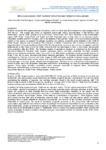Use este identificador para citar ou linkar para este item:
http://www.alice.cnptia.embrapa.br/alice/handle/doc/966811| Título: | Brazilian banana crop: current situation and research challenges. |
| Autoria: | RODRIGUES, M. G. V.  DONATO, S. L. R.   ROCHA, H. S.   ASPIAZÚ, I.   LICHTEMBERG, L. A.   |
| Afiliação: | MARIA GERALDA VILELA RODRIGUES, EPAMIG; SÉRGIO LUIZ RODRIGUES DONATO, IF Baiano; HERMINIO SOUZA ROCHA, CNPMF; IGNACIO ASPIAZÚ, UNIMONTES; LUIZ ALBERTO LICHTEMBERG, EPAGRI. |
| Ano de publicação: | 2013 |
| Referência: | In: REUNIÃO INTERNACIONAL ACORBAT, 20., 2013, Fortaleza. Acorbat: 40 anos compartilhando ciência e tecnologia. Fortaleza: Instituto Frutal: Acorbat Internacional, 2013. 320 p. |
| Conteúdo: | Brazil is the worlds fifth largest producer of bananas, with 7.3 million Mg, 503 thousand ha and average yield of 14.6 Mg ha-1. The country also holds an important market with unique characteristics. In the Northern and Northeastern regions, AAB varieties such as Pacovan, Dwarf Prata and Terra dominate. In the Southeastern region, AAB Prata, Dwarf Prata and Maçã and AAA Cavendish type, in that order. In the Southern region, Cavendish varieties and the Prata type, and, in the Midwest, Prata type and Maçã. In the main banana producing centers of the country, in general, the climatic conditions are suitable, except for water limitation in the North of Minas Gerais, Medium and Submedium São Francisco in Bahia, Submedium São Francisco at Pernambuco, Jaguaribe-Apodi in Ceará and Mossoró/Açú in Rio Grande do Norte, overcome with the use of irrigation; and low temperatures in São Paulo and in the South. Research with the crop began in 1925 in São Paulo, and became more consistent after the 1970s. The Brazilian system of agricultural research is constituted by the Brazilian Agricultural Research Company, state research companies, federal and state universities and other research, teaching and extension institutions. More than a fifth of the 453 articles published in leading scientific journals in Brazil, in the last 20 years, developed the theme improved genotypes. The Brazilian Banana Breeding Program, coordinated by Embrapa Cassava and Fruits, began in 1983 and made available to farmers several genotypes, since 1995. In the North of the country, where black Sigatoka is present and there are climatic conditions favorable to the pathogen, there was greater adoption the new genotypes. The banana crop in Brazil has evolved greatly in recent decades, due to the generation, adaptation and diffusion of technology, but also the organization of banana growers. Some highly technified production centers emerged, especially in irrigated areas, disseminating information and functioning as showcases positive for producers. |
| Thesagro: | Banana |
| Tipo do material: | Artigo em anais e proceedings |
| Acesso: | openAccess |
| Aparece nas coleções: | Artigo em anais de congresso (CNPMF)  |
Arquivos associados a este item:
| Arquivo | Descrição | Tamanho | Formato | |
|---|---|---|---|---|
| 1iNTRODUCAOBRASILIANBANANACROPHERMINIO.pdf | 472,36 kB | Adobe PDF |  Visualizar/Abrir |









